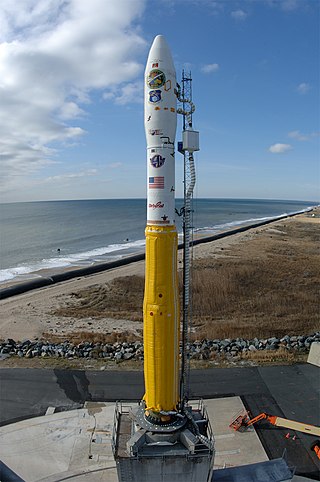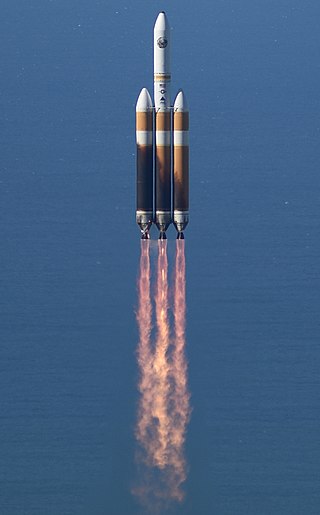
The Delta rocket family was a versatile range of American rocket-powered expendable launch systems that provided space launch capability in the United States from 1960 to 2024. Japan also launched license-built derivatives from 1975 to 1992. More than 300 Delta rockets were launched with a 95% success rate. The series was phased out in favor of the Vulcan Centaur, with the Delta IV Heavy rocket's last launch occurring on April 9, 2024.

Pegasus is an air-launched multistage rocket developed by Orbital Sciences Corporation (OSC) and later built and launched by Northrop Grumman. Pegasus is the world's first privately developed orbital launch vehicle. Capable of carrying small payloads of up to 443 kg (977 lb) into low Earth orbit, Pegasus first flew in 1990 and remained active as of 2021. The vehicle consists of three solid propellant stages and an optional monopropellant fourth stage. Pegasus is released from its carrier aircraft at approximately 12,000 m (39,000 ft) using a first stage wing and a tail to provide lift and altitude control while in the atmosphere. The first stage does not have a thrust vector control (TVC) system.
Orbital Sciences Corporation was an American company specializing in the design, manufacture, and launch of small- and medium- class space and launch vehicle systems for commercial, military and other government customers. In 2014, Orbital merged with Alliant Techsystems to create a new company called Orbital ATK, Inc., which in turn was purchased by Northrop Grumman in 2018. The remnants of the former Orbital Sciences Corporation became a subsidiary of Northrop Grumman, known as Northrop Grumman Space Systems.

A launch vehicle is typically a rocket-powered vehicle designed to carry a payload from Earth's surface or lower atmosphere to outer space. The most common form is the ballistic missile-shaped multistage rocket, but the term is more general and also encompasses vehicles like the Space Shuttle. Most launch vehicles operate from a launch pad, supported by a launch control center and systems such as vehicle assembly and fueling. Launch vehicles are engineered with advanced aerodynamics and technologies, which contribute to high operating costs.

Minotaur-C, formerly known as Taurus or Taurus XL, is a four stage solid fueled launch vehicle built in the United States by Orbital Sciences and launched from SLC-576E at California's Vandenberg Air Force Base. It is based on the air-launched Pegasus rocket from the same manufacturer, utilizing a "zeroth stage" in place of an airplane. The Minotaur-C is able to carry a maximum payload of around 1458 kg into a low Earth orbit (LEO).

The Minotaur is a family of United States solid fuel launch vehicles derived from converted Minuteman and Peacekeeper intercontinental ballistic missiles (ICBM). They are built by Northrop Grumman via contract with the Space Force’s Space Systems Command as part of the Space Force's Rocket Systems Launch Program (RSLP) which converts retired Intercontinental Ballistic Missiles into space and test launch systems for U.S. government agencies.

The Launch Vehicle Mark-3 or LVM3 is a three-stage medium-lift launch vehicle developed by the Indian Space Research Organisation (ISRO). Primarily designed to launch communication satellites into geostationary orbit, it is also due to launch crewed missions under the Indian Human Spaceflight Programme. LVM3 has a higher payload capacity than its predecessor, GSLV.

The Minotaur I, or just Minotaur is an American expendable launch system derived from the Minuteman II missile. It is used to launch small satellites for the US Government, and is a member of the Minotaur family of rockets produced by Orbital Sciences Corporation.

The Star 48 is the largest of a family of solid rocket motors used by many space propulsion and launch vehicle stages, almost exclusively as an upper stage. It was developed primarily by Thiokol Propulsion and after several mergers, is manufactured by Northrop Grumman’s Space Systems division. A Star 48B stage is also one of the few man-made items sent on escape trajectories out of the Solar System, although it is derelict since its use. The Star 48B variant was the PAM-D upper stage used on the retired Delta II rocket.
The Space Test Program (STP) is the primary provider of spaceflight for the United States Department of Defense (DoD) space science and technology community. STP is managed by a group within the Advanced Systems and Development Directorate, a directorate of the Space and Missile Systems Center of the United States Space Force. STP provides spaceflight via the International Space Station (ISS), piggybacks, secondary payloads and dedicated launch services.

Antares, known during early development as Taurus II, is an expendable launch system developed by Orbital Sciences Corporation and the Pivdenne Design Bureau to launch the Cygnus spacecraft to the International Space Station as part of NASA's COTS and CRS programs. Able to launch payloads heavier than 8,000 kg (18,000 lb) into low Earth orbit, Antares is the largest rocket operated by Northrop Grumman. Antares launches from the Mid-Atlantic Regional Spaceport and made its inaugural flight on April 21, 2013. Antares 100 was retired in 2014 and series 200 was retired in 2023 due to component unavailability. As of January 2024 Antares 300 is under development.

The Delta IV Heavy was an expendable heavy-lift launch vehicle, the largest type of the Delta IV family. It was the world's third highest-capacity launch vehicle in operation at the time of its retirement in 2024, behind NASA's Space Launch System and SpaceX's Falcon Heavy and closely followed by CASC's Long March 5. It was manufactured by United Launch Alliance (ULA) and was first launched in 2004. ULA retired the Delta IV Heavy in 2024. Future ULA launches will use the new Vulcan Centaur rocket. Delta IV's final flight was in 9 April 2024.
The Operationally Responsive Space Office is a joint initiative of the United States Department of Defense (DoD). The "stand up" of the office took place 21 May 2007 at Kirtland Air Force Base. The first director of the ORS Office was Col. Kevin McLaughlin, who was also the commander of the Space Development and Test Wing located at Kirtland. The ORS Office focuses on providing quick-response tactical space-based capabilities; utilizing smaller satellites, such as the Tactical Satellite Program and smaller launch vehicles.

The Space Launch Complex 46 (SLC-46), previously Launch Complex 46 (LC-46), is a launch complex at Cape Canaveral Space Force Station operated under license by Space Florida previously used for Athena rocket launches. It has been used by Astra, which will continue the use with Rocket 4 and maybe 5 and will be used by ABL Space Systems for the near-term use by RS1.
The Minotaur III, also known as OSP-2 Target Launch Vehicle, Peacekeeper TLV, or OSP-2 TLV was an American rocket concept derived from the LGM-118 Peacekeeper missile. It was a member of the Minotaur family of rockets produced by Orbital Sciences Corporation and would have been used for long-range suborbital launches with heavy payloads. The Minotaur III was to be capable of launching 3,000 kilograms (6,600 lb) of payload 5,000 kilometres (3,100 mi) downrange. This role has been taken over by the near-identical Minotaur IV Lite and the lighter-lift Minotaur II.
USA-221, also known as FalconSat-5, is an American military minisatellite, which was launched in 2010. The fifth FalconSat spacecraft to be launched, it carries four technology development and ionospheric research experiments. The satellite was constructed and is operated by the United States Air Force Academy.
The Star is a family of US solid-propellant rocket motors originally developed by Thiokol and used by many space propulsion and launch vehicle stages. They are used almost exclusively as an upper stage, often as an apogee kick motor.

Astra Space, Inc. is an American launch vehicle company based in Alameda, California. Astra was incorporated in October 2016 by Chris Kemp and Adam London. Formerly known in media as "Stealth Space Company", the company formally came out as Astra Space, Inc. in a Bloomberg L.P. article by Ashlee Vance. Investors include BlackRock, Advance, ACME, Airbus Ventures, Innovation Endeavors, Salesforce co-founder Marc Benioff, former Disney CEO Michael Eisner, and more.
The BE-3 (Blue Engine 3) is a LH2/LOX rocket engine developed by Blue Origin.

A small-lift launch vehicle is a rocket orbital launch vehicle that is capable of lifting 2,000 kg (4,400 lb) or less or under 5,000 kilograms (11,000 lb) of payload into low Earth orbit (LEO). The next larger category consists of medium-lift launch vehicles.














